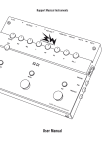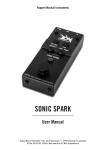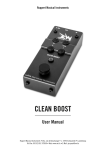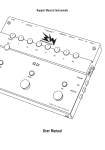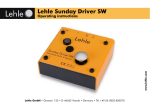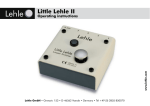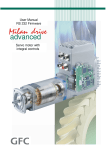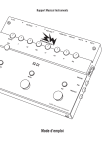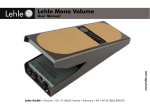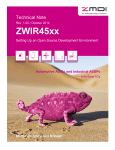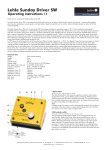Download manual
Transcript
Ruppert Musical Instruments ACOUSWITCH JUNIOR User Manual Ruppert Musical Instruments 20a, rue de Bascharage L - 4995 Schouweiler Luxembourg Tel./Fax: 00 352 691 379050 Web: www.rmi.lu E-Mail: [email protected] Congratulations! With the RMI Acouswitch Junior you have purchased a high-quality piece of musical equipment that will open up new dimensions in amplification of acoustic instruments and signal routing. When developing the RMI Acouswitch Junior we focused on the needs and wishes of the professional musician who is not willing to compromise on either sound or the technical quality of the equipment. The RMI Acouswitch Junior is manufactured, assembled and tested in Germany to the highest quality standards using only the best brand components available to ensure optimal treatment of the electrical signal from your instrument. The RMI Acouswitch Junior is an all-rounder, equally suitable for electric and acoustic instruments. Whether the signal comes from a magnetic or a piezo pickup, the high-end preamp of the RMI Acouswitch Junior will ensure that their specific characteristics are uncompromised. Due to its functional design, the RMI Acouswitch Junior offers an “all-in-one” solution for every musician who performs on stage with both electric and acoustic instruments. The RMI Acouswitch Junior can be used in standalone mode or as the control centre of a pedal board. It is an A/B input switcher, a high-end preamp, a clean booster, a 4-band EQ, an FX loop switcher and last but not least a professional-quality active DI box. The different operating modes allow a variety of uses united in the smallest space. I wish you every success with your RMI Acouswitch Junior. Yours, Jacques Ruppert Summary Introduction 4 Setting the operating modes 5 Description 8 Examples of possible setups 13 Tech Talk 16 Signal Flow Diagram 18 Technical data 19 Product Guarantee 20 Introduction Why a specific preamp/switcher/DI pedal for acoustic instruments AND electric instruments? The reasons are obvious: Many musicians use different instruments on stage, switch between electric and acoustic guitars, between cello and electric guitar or other instruments back and forth, which they also like to independently mute, boost or send though a few effects as well as route them arbitrarily to an amp or to a DI-box, or a mixer. However, acoustic instruments have a characteristic attack with a very steep initial transient followed by a weak electrical signal. On top of this, the frequency range of acoustic instruments goes from deep fundamentals (e.g. the low C-string of a cello approx. 65 Hz) to very high overtones that have a crucial impact on the timbre of the acoustic instrument even though they are approaching the upper limits of the audible spectrum. These characteristics of acoustic signals make enormous demands on the electronics. Only equipment specifically designed for the purpose is able to handle such a demanding signal pattern adequately. The Acouswitch Junior is able to meet these requirements. The A/B foot switch permits toggling between the two inputs. If no cable is connected to the instrument B input, the signal from instrument A can be routed to channel A or B by using the A/B foot switch. Where and how your instrument signal is switched, depends on the selected operating mode. In Classic Mode the selected instrument is always routed to both outputs, whereas in Electro Acoustic Mode the outputs are alternately muted depending on the selected instrument input. In Teacher’s Mode there is a mix-function, which means that you can also toggle between A+B and B only. For details about the switching functions see Changing the operating mode of the A/B switch (p. 5). Functions and applications overview The Acouswitch Junior offers versatile applications that can be adjusted before use. For details on how the modes can easily be switched see Setting the operating modes. If you have any questions feel free to contact our support [email protected] - Acouswitch Junior as high-end preamp with 4-band EQ Channel A of the Acouswitch Junior features a high-end preamp and a 4-band EQ specifically designed for acoustic instruments. Featuring bass, low mids, high mids and treble controls, it is easy and intuitive to use. In stand-alone use the pedal can drive a poweramp, an active monitor or an in-ear monitoring system. Channel B pursues the philosophy of not routing the signal through unneeded electronics, but rather keeps it pure and unprocessed. For this reason channel B has no EQ. Since each channel has its own volume controller, the volume of both channels can be easily balanced in any operating mode. - Acouswitch Junior as A/B input switcher The inputs A and B have an impedance of 5 MOhm each. Both inputs can be used for different instruments. - Acouswitch Junior as FX looper The Acouswitch Junior has one serial FX loop, which depending on the operating mode can be switched. In Loop Boost Mode this FX loop 4 can be switched together with the boost function. How to change the mode of the Mute/ Loop/Boost switch to Loop Boost Mode see Changing the operating mode of the Mute/ Loop/Boost switch (p. 6). high-quality components and features of the Acouswitch Junior (high-end preamp, ground switch, PRE/POST signal processing switch, rugged construction) make the Acouswitch Junior an excellent DI box, be it in a live setting or in a recording situation. - Acouswitch Junior as clean booster Depending on the operating mode of the Mute/ Loop/Boost switch a second, controllable amplifier stage can be added via the foot switch behind the serial FX loop. The final amplification of the booster can be adjusted via the BOOST potentiometer. The mode in which the boost function is switched exclusively is called the Boost Mode. Here, the Mute/Loop/Boost button switches the booster on and off. In Mute Mode this second amplifier stage is always on, so the final volume can be adjusted via the BOOST potentiometer. Additional features - TUNER OUT: Connect your tuner here to keep it out of the signal path and prevent potential sound losses. This way the tuner can be on all the time allowing you to check your tuning on the fly. - Lehle True Sound Technology (for details please consult the chapter Tech Talk p. 16). - Specially design to protect the controls from damage and to prevent inadvertent changes to the settings. - The design of the housing permits easy installation: the ultra-flat base and removable rubber feet allow the unit to be securely attached to the pedal board using Velcro or similar. - Acouswitch Junior as DI box The Acouswitch Junior can be used to send the output signal directly to a mixing console. The Setting the operating modes Changing the operating mode of the A/B switch To change the operating mode of the A/B switch (line-in, foot switch on the right) proceed as follows: 1. Disconnect the Acouswitch Junior from the power supply. As a precaution, we recommend to disconnect all other cables or at least to ensure that all devices connected to the Acouswitch Junior are turned off. Otherwise unwanted noise could occur. 2. Keep the A/B button pressed. 3. Connect the Acouswitch Junior to the mains supply by plugging the power supply plug into the fitting input jack (9-15 V, leftmost) of your Acouswitch Junior. 4. The LED above the A/B button now flashes a sequence of 3 different flashing signals: ● • (flashes 1x) → Classic Mode ●● • • (flashes 2x) → Electro Acoustic Mode ●●● • • • (flashes 3x) → Teacher’s Mode Depending on the flashing signal that is shown at the moment you release the A/B button, you choose Classic Mode, Electro Acoustic Mode or Teacher’s Mode. The selected mode will stay even when you disconnect your Acouswitch Junior from the power supply, until you set another operating mode as described above. 5 In Classic Mode input A and B are switched alternately, so B is muted when A is on and vice versa. If input A (INST A) is selected, the LED above the foot switch will shine blue, if INST B is activated, the LED will light up (steady) white. The outputs Line Out and DI Out are always on, so the selected instrument signal is always routed to both outputs. Shortly: LED shines blue – INST A selected – EQ – Line Out and DI Out on. LED shines white – INST B selected – no EQ – Line Out and DI Out on. No mixing function. example teacher and student). If you switch now and the LED shines white, only input B will be active and routed to both outputs. In Teacher’s Mode, the mix-function also allows to use two pickup systems for the same instrument (e.g. mic and piezo) simultaneously and mix, boost, switch and filter them with the Acouswitch Junior. Shortly: LED shines blue – Mix on, INST A and INST B, Line Out and DI Out on. Signal A with EQ, Signal B without EQ. LED shines white – INST B only, Line Out and DI Out on. The instrument signal stays clean. In Electro Acoustic Mode, as in Classic Mode, the two instruments are switched alternately, so B is muted if A is on and vice versa. The special feature of this mode is that each input is exclusively assigned to an output. The respectively other output will then be muted. Instrument A, which is supposed to be an acoustic instrument, will then be routed to the DI Out. Instrument B, an electric guitar for example, will be solely routed to Line Out, which could be connected to a guitar amp for example. Shortly: LED shines blue – INST A selected – EQ – DI Out on – Line Out muted. LED shines white – INST B selected – Line Out on – DI Out muted. No mixing function. Changing the operating mode of the Mute/ Loop/Boost switch To change the operating mode of the Mute/ Loop/Boost switch (foot switch on the left) proceed as follows: 1. Disconnect the Acouswitch Junior from the power supply. As a precaution, we recommend to disconnect all other cables or at least to ensure that all devices connected to the Acouswitch Junior are turned off. Otherwise unwanted noise could occur. 2. Keep the Mute/Loop/Boost button pressed. 3. Connect the Acouswitch Junior to the mains supply by plugging the power supply plug into the fitting input jack (9-15 V, leftmost) of your Acouswitch Junior. 4. The LED above the A/B button now flashes a sequence of 4 different flashing signals: ● • (flashes 1x) → Mute Mode ●● • • (flashes 2x) → Loop Mode ●● • • • (flashes 3x) → Boost Mode • • • • (flashes 4x) → Loop Boost Mode Depending on the flashing signal that is shown at the moment you release the A/B button, you choose Loop Boost Mode, Boost In Teacher’s Mode, there is now a mixing function: If the LED shines blue, both inputs are selected and will also be routed to both outputs. So, two instruments can be amplified simultaneously and connected e.g. with a guitar amp via Line Out and with a mixer via DI Out. This way, two players can use the same amp (for 6 In Boost Mode the Mute/Loop/Boost button affects only the boost function. The serial FX loop is active whether the instrument signal is boosted or not. In this configuration, the Mute/Loop/Boost button also has no mute function. Shortly: LED shines blue – Boost and Loop on, Mute inactive. LED is off – Boost off, Loop on, Mute inactive. Mode or Mute Mode. The selected mode will stay even when you disconnect your Acouswitch Junior from the power supply, until you set another operating mode as described above. In Mute Mode, the serial FX loop (Loop) and the boost are active, when the LED is off (dark); when the LED shines blue, all will be muted. Shortly: LED shines blue – Mute on – Line Out and DI Out muted. LED is off – Loop and Boost on. In Loop Boost Mode, the Mute/Loop/Boost button switches the serial FX loop along with the booster. In this configuration, the Mute/Loop/Boost button has no mute function. When the LED shines blue, the Boost function (intensity can be set via the Boost potentiometer) is selected, as is the serial FX loop. If the LED is off, in Loop Boost Mode boost function and FX loop are off. Shortly: LED shines blue – Loop and Boost on, Mute inactive. LED is off – Loop and Boost off, Mute inactive. In Loop Mode, the Mute/Loop/Boost button affects only the loop function. The serial effects loop is active when the LED shines blue. The boost function is always active. In this configuration, the Mute/Loop/Boost button has no mute function. Shortly: LED shines blue – Loop on, Boost on, Mute inactive. LED is off – Loop off, Boost on, Mute inactive. 7 Description 7 6 5 12 11 4 10 3 9 2 1 8 19 14 13 16 15 18 20 21 17 1. Input INST A Connect your first instrument here. We recommend this input jack for acoustic instruments, because this input to channel A has the tone controls, and is routed to the DI Out in Electro Acoustic Mode. The input gain for this channel can be adjusted via VOL A. pure and unprocessed. The input gain for this channel can be adjusted via VOL B. If only Input A is being used the foot switch toggles the input A signal between channel A and channel B. This allows to set up your basic sound on your amp using the straight-through channel B and to have a second sound-setting available by pressing the foot switch, either for a second instrument or for a change of style. 2. Input INST B Connect your second instrument here – or the 2nd pickup of the same instrument. In Electro Acoustic Mode, INST B is the appropriate input jack for the electric instrument, because the signal from INST B then will be routed to LINE OUT. Channel B pursues the philosophy of not routing the signal through unneeded electronics, but rather keeps it 3. LINE OUT Connect your amplifier here. When operating the Acouswitch Junior in Electro Acoustic Mode the amp for the electric instrument should be connected here. In this mode, only the signal from INST B is routed to the LINE OUT, but not the signal INST A. 8 4. TUNER OUT Connect your tuner here. Connecting your tuner here guarantees that the tuner is completely out of the signal path and does not cause sound losses. It allows you to keep your tuner on all the time so that you can check your tuning and intonation control on the fly. To defeat the sound while tuning, set the Mute/Loop/Boost button to Mute Mode and then switch the Mute/Loop/Boost button until the LED shines blue. Then, the MUTE button defeats both the LINE OUT and the DI OUT. the best out of your pedal setup we recommend that you use high-quality power supplies with isolated output sections in your setup! 8. Volume control channel A Adjust with this control the volume of channel A. This control adjusts the volume of channel A. To permit optimal matching of the volume between channel A and channel B this control enables you to boost and to cut the signal, the neutral position is at 12 o’clock. The high-end preamp used here allows you to connect the Acouswitch Junior directly to a power amp. 5. SEND output (Serial Loop) Connect the first effect you want to run in the serial loop here. The serial loop allows to integrate an external effects unit. 9. Bass control Adjust with this control the amount of bass in your tone of channel A. The bass control B is specifically designed for acoustic instruments in order to cut or boost the low frequencies by +/- 15 dB with a peak filter characteristic of about 80 Hz. 6. RETURN input (Serial Loop) Connect the output of the last effect connected to the SEND of the serial loop here. If the Return jack is not used, the signal from the send jack is present. The return socket can also be used for a third active instrument. If the Loop or Loop Boost Mode is active (see Changing the operating modes of the Mute/ Loop/Boost switch), the Loop Boost button will activate the third instrument. 10. LM control Adjust with this control the amount of low mids of channel A. This control is designed for cutting and boosting the low mids by +/- 15 dB with a peak filter characteristic. The spectrum to be controlled is already preset and is at 360 Hz. 7. External power supply Connect your external power supply here (9-15 V DC or 7-12 V AC; 150 mA min.). Battery operation is not suitable for this device. The external power supply should provide not less than 9 V and not more than 15 V. Either alternating (AC) or direct current (DC) sources can be used and the polarity is not relevant. AC power sources from 7 to 12 V can also be used. The voltage supplied is internally rectified, filtered, stabilised and then brought to 18 V. To get 11. HM control Adjust with this control the amount of high mids of channel A. This control is designed for cutting and boosting the high mids by +/- 15 dB with a peak filter characteristic. The spectrum to be controlled is already preset and is at 2 kHz. 12. Treble control Adjust with this control the amount of treble of channel A. 9 With the treble control you can cut or boost high frequencies by +/- 12.5 dB via a shelving filter at 10 kHz. LED shines white – INST B selected – Line Out on – DI Out muted. No mix function. 13. Volume control channel B Adjust with this control the volume of channel B. This control adjusts the volume of channel B. To permit optimal matching of the volume between channel A and channel B this control enables you to boost and to cut the signal, the neutral position is at 6 o’clock. Teacher’s Mode LED shines blue – Mix on, INST A and INST B, Line Out and DI Out on. Signal A with EQ, Signal B without EQ. LED shines white – INST B alone, Line Out and DI Out on. Instrument signal stays unchanged. For details see Changing the operating mode of the A/B switch (p. 5). 14. BOOST control Adjust with this control the boost level or the output volume of the entire device. Whether the booster is switched on or always is on, depends on the mode of the Mute/Loop/ Boost control see Changing the operating mode of the Mute/Loop/Boost switch (p. 6). The booster is behind the serial FX loop. In Boost Mode the booster can be used as solo boost. In Loop Boost Mode the serial loop is switched together with the Boost. For all modes applies: BOOST control rightmost (1 o’clock): no gain; control leftmost (11 o’clock): gain of +12 dB. The signal level can therefore only be boosted, but not cut with this potentiometer. 16. Status display for MUTE/LOOP BOOST This LED shows different switching statuses depending on the adjusted mode. The LED shines blue, when the preset function is on. That means: In Mute Mode: LED shines blue – Mute on, all is muted. LED is off – Loop and Boost on. In Loop Mode: LED shines blue – Loop and Boost on, Mute inactive. LED is off – Loop off, Boost on, Mute inactive. 15. Status display for foot switch A/B This LED shows different switching statuses depending on the adjusted mode. In Boost Mode: LED shines blue – Boost and Loop on, Mute inactive. LED is off – Boost off, Loop on, Mute inactive. Classic Mode LED shines blue – INST A selected – EQ – Line Out and DI Out on. LED shines white – INST B selected – no EQ – Line Out and DI Out on. No mix function. Electro Acoustic Mode LED shines blue – INST A selected – EQ – DI Out on – Line Out muted. In Loop Boost Mode: LED shines blue – Loop and Boost on, Mute inactive. LED is off – Loop and Boost off, Mute inactive. For details see Change the operating mode of the Mute/Loop/Boost switch. 10 17. A/B foot switch Press this switch depending on the mode to select between INST A and INST B, to route from INST A to channel A or B or to switch between INST A + INST B or just INST B. The function of this switch changes depending on the selected mode. It is also dependent on whether an instrument is connected to INST B or not. In Classic Mode this switch toggles between INST A and INST B, the signal is routed to both outputs. In Electro Acoustic Mode both instrument inputs are also alternately switched, but in this mode each input is exclusively assigned to one output, the respectively other output is then muted. Thanks to the mix function in Teacher’s Mode there is the option to switch INST A + INST B against INST B alone. For details see Change the operating modes of the A/B switch. Is just an instrument connected to INST A and INST B remains free, the A/B switch effects a switchover of the input signal to channel A with EQ or channel B. That way you can toggle with one instrument between two different sounds. The switched signal is symmetrically available at the DI output. Whether and which signal is routed to the DI Out depends on the operating mode of the A/B switch. In Classic Mode the selected signal is always routed to the DI Out, whereas in Electro Acoustic Mode the DI Out is muted, when channel B is on. In Teacher’s Mode the selected input signal (A+B or B) is always transmitted to the DI Out. The maximum level at the DI Out is about +10 dBU. 20. GROUND switch Press the GROUND switch to eliminate ambient noise. In pressed condition the shielding of the Acouswitch Junior and the XLR cable get connected. When you have any doubts adjust the GROUND switch through trial and error to have no humming noise. 21. PRE/POST switch Press the PRE/POST switch to eliminate the EQ and the loop from the DI signal path. By pressing this switch the signal goes directly to the DI output without passing through the EQ, the serial loop or the boost of the Acouswitch Junior. The Line Out is not affected. For studio recordings it is more advantageous to record the signal unedited and edit it later. This setup enables the musician to hear his recorded signals as usual with EQ and effects via Line Out in the PRE-mode, while at the same time the signal of the instrument is picked up directly behind the Volume control of channel A or B and transmitted via the DI output of the Acouswitch Junior unedited. The effects can be added to the recording during the mix via re-amping, which usually leads to better results. 18. MUTE/LOOP/BOOST foot switch Press this switch depending on the mode for turning on/off the booster, the effects loops or the muting. The function of this switch changes depending on the selected mode. You can optionally turn on/off the boost, turn on/off the effects loop and the boost or muting the Acouswitch Junior. For details of the modes and how to operate them, see Change the operating mode of the Mute/Loop/Boost switch. 19. DI OUT Use this output for connecting the Acouswitch Junior with an XLR cable to a mixing console. 11 Examples of possible setups 12 1. The Acouswitch Junior as A/B-switcher/preamp/booster/DI in a stand-alone application 2. The Acouswitch Junior as A/B-switcher/preamp/booster/DI on a pedal board LOW MIX LEVEL REGEN HIGH RATE DEPTH DELAY analog delay analog chorus 13 3. The Acouswitch Junior as a preamp/booster/DI in a stand-alone application 4. The Acouswitch Junior as a preamp/booster/DI on a pedal board LOW MIX LEVEL REGEN HIGH RATE DEPTH DELAY analog delay analog chorus 14 5. The Acouswitch Junior as a preamp/booster/DI in a stand-alone application with three instruments 6. The Acouswitch Junior as A/B-switcher/preamp in a student-teacher application 15 Tech Talk True Bypass and True Sound Today more and more effect pedals feature true bypass switching to completely bypass the pedal in the signal routing when the pedal is switched off. The target of this design is to ensure that the pedal does not affect the electrical signal when it is switched off. This way the sound is left unaltered - in theory. In practice, however, connecting several pedals featuring a true bypass design in series does not improve the sound or keep it unaltered at all. Long runs of cable and multiple connections lead to a weak and lifeless sound. On large pedal boards the overall length of the cable is enough for the capacitance of the cable have a negative effect on the sound. The capacitance of the cable acts as a low-pass filter (= the low frequencies pass through the filter while the high frequencies are filtered out). The price and quality of the cable you are using will not change this physical phenomenon. A solution would be to use only devices with buffered bypass design instead of true bypass. This, however, is only a good solution if the buffer is of very high quality. If several units with buffered bypass are connected in series it only needs one buffer to be noisy, cut the dynamics of the sound signal or negatively affect the sound in any other way for the sound of the whole effect chain to be spoilt. As the saying goes “a chain is only as strong as its weakest link”. In addition, the noise of the individual buffers adds up to produce audible noise; it is a fact that every buffer produces some noise, even if it cannot be heard when only a single buffer is used. The ideal solution is to have a very high-quality buffer at the beginning of the chain that brings the signal down to a very low impedance. This makes the signal insensitive to the length of the cable. It is important, however, that this buffer is of the highest quality with the dynamic range and headroom necessary to ensure that all the details of the bass signal stay are retained unaltered. The effect pedals in the downstream loops should then ideally have true bypass so that they will not have a negatively effect on the now buffered signal, as the true bypass design does not reduce dynamics and headroom or produce any noise. Conclusion: having a True Sound Lehle buffer at the beginning of your effect chain combined with good true-bypass-equipped effects in the loop guarantees the best sound. What is Lehle True Sound Technology? Lehle True Sound Technology is a combination of several electrical design measures with only one aim in view: to transmit the sound and the character of the instrument without altering it. The voltage supplied to the Acouswitch Junior is internally rectified, filtered and stabilised and then brought to 18 V. Supplying the buffer with 18 V gives enough headroom to guarantee an open and dynamic sound in all situations without losing any detail, even when confronted with pickup power peaks of up to around 7 V. The buffers are designed to effortlessly handle signals reaching the megahertz range. At the output, the frequency bandwidth is limited to prevent HF interference from, disturbing the electronic circuitry. This technology guarantees optimal transient response by the circuitry and is key to obtaining a sound that is transparent and, above all, cuts through. For switching, Lehle True Sound 16 Technology uses exclusively gold-plated contact relays and/or gold-plated switches. The decaying signal from a string is so weak that contact materials with lower conductivity have a negative impact on the sound. Ordinary foot switches use contact materials developed to switch high voltages (e.g. electrical power tools) as this is their main field of application. This can be heard, for example, when, after a switch has been in use for some time, a decaying tone starts to break off abruptly. Relays and switches with gold-plated contacts do not have this problem and even the smallest electrical signals can be transmitted for years without being negatively affected. In addition, the relays used in the Acouswitch Junior have a lifetime about 100 times as long as those used in ordinary foot switches. Together with typical Lehle electronic circuitry to reduce the switching pop of relays, the combination of the above design features represents today’s state-of-the-art solution for an uncompromising preservation of the signal and hence the sound and character of the instrument. metal lever. Because the actuator button and the internal push button are not directly connected, the load exerted by the foot is absorbed by the actuator button and the housing, preserving the circuit board from mechanical stress. The design is as robust as possibly and the actuator button mounted in a special socket making for easy and silent operation. Inside the Acouswitch Junior the impulse from the push button triggers a processor based on the ARM Cortex-M technology which controls the switching operation very quickly and precisely. This way the switching is done only via high-quality relays and thus guaranteeing absolutely reliable and loss-free switching of very sensitive signals. The switching technology and the gold-plated relays in the Acouswitch Junior are designed to operate for up to two million switching cycles! Working principle of the Acouswitch Junior foot switches Foot switches are pressed thousands of times during their long life – sometimes sensitively but some times more brutally depending on the situation and the musician’s temperament. An ordinary foot switch will switch up to 20,000 times before wearing out mechanically or electrically, which means that either it will stop working altogether or the signal will start to lose transparency and dynamics. The Acouswitch Junior is equipped with high-quality Lehle foot switches. Here the foot of the musician does not press an ordinary foot switch but an actuator button that activates a push button inside the Acouswitch Junior via a 17 Instr B Signal Flow Diagram Technical data: Weight: Length: Width: Overall height: Voltage range: Power consumption: Frequency range: Distortion: Input A impedance: Input B impedance: Send impedance: Return Impedance: Output impedance: Signal-to-noise ratio: Max. level: Max. gain: EQ Bass: Low Mid: High Mid: Treble: 1,065 g 15 cm (5.9") 16 cm (6.3") 4.3 cm (1.7") 9-15 V DC, 7-12 V AC max. 150 mA 50 Hz (Low-cut-Filter) – 100 kHz (+0, -2 dB) 0,005 % 5 MOhm 5 MOhm 250 Ohm 50 kOhm 250 Ohm -94 dB at 1 kHz, 0 dBU (22 Hz - 22 kHz) 5 V RMS (ca. 16 dBU) +/- 15 dB +/- 15 dB @ 80 Hz (peaking) +/- 15 dB @ 360 Hz (peaking) +/- 15 dB @ 2 kHz (peaking) +/- 12.5 dB @ 10 kHz (shelving) Product Guarantee 1. This product is covered by a limited scope Product Guarantee for a period of two years from the date of purchase of the unit. 2. The guarantee is restricted to the free-ofcharge rectification of material and manufacturing defects by means of repair or replacement, at the manufacturer‘s option. 3. The guarantee includes free-of-charge return of the unit to the customer. The customer shall bear the costs of returning the unit to the Lehle Customer Service. 4. All guarantee repairs shall be performed by a customer service organization authorized and approved by Lehle GmbH. 5. The guarantee shall be deemed to become null and void if the product has been modified or damaged by incorrect use, negligence, dismantling, changes made by non-authorized customer service organizations or by the use of non-original spare or replacement parts. Please proceed as follows if it should become necessary to return your product: 1. Please firstly contact us (support@lehle. com), in order that the fault can be ascertained and trouble-free processing assured. 2. Please submit to us documentation (receipts or similar) clearly and unequivocally proving the date of purchase of the unit. 3. Please send the unit carefully packed (the original packing is best!) at your own expense to: Lehle GmbH Grenzstrasse 153 46562 Voerde Germany or to an authorized customer service organization named by ourselves. 6. Lehle GmbH is unable to accept any liability whatsoever for any and all consequential damage resulting from the use of this product. Ruppert Musical Instruments 20a, rue de Bascharage L - 4995 Schouweiler Luxembourg Tel./Fax: 00 352 691 379050 Web: www.rmi.lu E-Mail: [email protected]




















